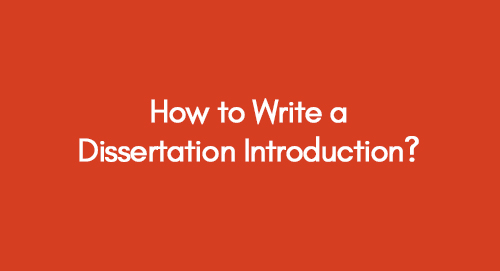
How to Write a Dissertation Abstract?
July 20, 2022
150+ Cryptocurrency Dissertation Topics in 2025
July 28, 2022In the dissertation introduction, providing background information relevant to your research focus is crucial. This sets the stage for understanding your excitement, research significance, and impact. Articulating your main topic's goals and objectives underscores its importance and the need for such research.
Explore More About Introduction in Research Here
In your dissertation, the introduction section is vital and adds great value to your research. This demonstrates your assessment of how your work contributes to existing academic literature, which is essential for evaluating its merit by others. Crafting a compelling and engaging start to your academic journey is crucial – explore our expert tips on how to write a dissertation introduction that captivates your readers.
What Should You Be Included in Your Introduction?
Having outlined the importance of a dissertation introduction, we can now move on to what makes an engaging introduction. Here we will discuss the main facets. Make sure that none of these are missed. All of them serve a specific purpose. You will not be able to get an overall view of your dissertation if you discard any one of these points. So let us take a closer look at each one.
The Topic and Context
You should start by describing the details of your topic. Introduce it briefly. A good introduction always starts with finding a good topic. The first sentence of the dissertation should entice the reader to keep reading. Maintain a formal, professional tone. You should emphasize how what you have written is extremely important and fills in the gaps that other dissertations or research articles have missed. Following this principle, your reader will be interested in what you have written. The reader must also be given a glimpse of what comes next because, in this case, the stage has been set to present the rest of the sections.
The Scope of Your Study
Now that you know the dissertation's background and topic details, it is time to turn your attention to its scope. Write it from the perspective of a 360-degree view, and be brief. Explain your geographic area in detail. Explain when you conducted your research. Explain who conducted the research. What were the subjects of your study? You should be specific about the topics of the dissertation. PhD dissertations require extensive research and simulations to be written. Be sure to include the entire scope in your writing so the reader is aware of "what, who, and how."
Significance of Your Research
An important part of writing a dissertation is convincing your readers that a problem exists and why it should be solved. Your conclusion will be based on the findings, and your recommendations will be presented. Explain how your research contributes to the field. As a result, you will be creating a case for how your work will truly add value to the scientific and academic communities. It is important to explain why you chose the industry or company for your dissertation. Professors are always critical of students' work. Using this method, you will be able to convince the audience that the topic or concept deserves further research.
Research Problem
Your next step will be to formulate a strong problem statement after describing the significance of your research. A dissertation introduction must include this because it will let your readers know what to expect.
This will, in short, compel them to read the entire dissertation. It is the heart of the paper. The main goal of the introduction is to get the reader interested. Make sure to write this statement considering the main purpose of your dissertation and why you wrote it.
Research Question
A comprehensive introduction will begin with the Research Question. Research questions are determined based on the title of the dissertation and the research problem. Taking advantage of both aspects, you can formulate a question with a great deal of depth. It will be the basis of your dissertation. You might not get a passing grade if you fail to answer this question. The rules are clear. Therefore, write a clear and specific research question.
Describe Your Goals and Objectives
The purpose of these statements is to let the reader know what your dissertation seeks to achieve. This is an extension of your research question. It is best to begin such statements with "to study, understand, explore or evaluate". Check out examples online before trying to write your own. There should be a connection between aims and objectives, and they must be consistent with the main topic and question.
What are Your Research Limitations?
Explain your limitations after you have written your methodology. Do not consider them negative. A dissertation will always have limitations. These can be either financial or in terms of data. Be sure to seek your supervisor's assistance when writing this part of the dissertation. Review some sample dissertations and conclusions to help with writing a dissertation or a conclusion.
The Research Overview
Assume you are asked to write an essay about a topic that is not widely discussed, so you have to elaborate. Your readers will need some background information to get them up to speed. In a similar manner, when writing an introduction to your dissertation, you must describe your method. The audience will be interested in your presentation this way. They will know what to look forward to next. Previews do not take a lot of time to write. Include the hypotheses, methods, and results. Keeping them brief will prevent you from giving away too much detail. Since the rest of the sections specifically deal with these specific topics, you do not need to give away too much information. Readers will gain a better understanding of your dissertation and can decide whether they can cite it or not. The rationale that you are covering the gap that previous dissertations missed will also be able to be explained.
Dissertation Outline
It is common to design an overall outline for your dissertation, depending on the university, program, and subject you are studying. You can prepare this outline before you begin your research. You can check your intended research by showing this outline to your instructor or tutor, who can then point out any mistakes or improvements. In this way, you can receive feedback more easily. The section where you outline your dissertation proposal will include an outline of all the concepts, sections, and aspects it contains. A dissertation has five main parts: introduction, literature review, methodology, results, and conclusion.
The findings and discussion of dissertations are rarely based on these chapters. The findings and discussion are often combined by splitting the two chapters into two. Be sure to follow the formatting requirements of your professor. Do not forget to include brief summaries and general ideas regarding your paper in your outline.
About 10 percent of the total word count of the thesis can be devoted to the introduction. You may have an introduction of between 8,000 and 10,000 words if you are doing a PhD of 80,000 - 100,000 words. When you are composing a Master's thesis of 15,000 - 20,000 words, your introduction should be 1,500 - 2,000 words.
FAQs About Dissertation Introduction
Get 3+ Free Dissertation Topics within 24 hours?




























